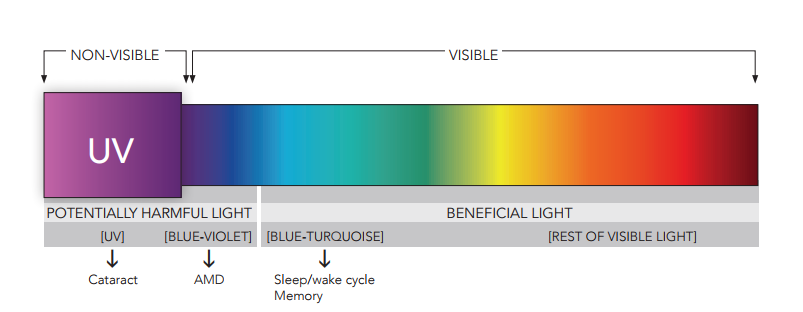
Overexposure to UV light can lead to ocular conditions such as photokeratitis, cataracts, pterygium, and macular degeneration.
Photokeratitis – a sunburn of the eye causing severe pain. The condition is also known as “snow blindness.” Up to 80% of UV rays are reflected by the snow and the danger also occurs near swimming pools and the beach.
Cataracts – the most common cause of reversible vision loss in people age 50 and older. The UV rays cause clouding of the natural lens located in the eye by disrupting the arrangement of the fibers of the lens. The World Health Organization (WHO) estimates that up to 20 percent of all cataract cases are attributed to UV radiation and are preventable.
Pterygium – sometimes called “surfer’s eye” is an abnormal but benign growth on the surface of the eye starting in the corner near the nose and extending to the front of the eye (cornea). Pterygium is linked to excessive exposure to the sun, wind or sand. Childhood UV exposure increases the risk of pterygium.
Macular degeneration – Leading cause of blindness in people 60 years of age or older. Studies suggest that exposure to UV early in life, rather than in later years, is a strong predictive factor for developing macular degeneration. The macula is the tissue behind the eye that located in the center of the retina to provide clear central vision. Damage to the macula causes blurred detailed vision and dull colors in the center field of vision.

The sun emits three kinds of radiation: UVA, UVB, and UVC. UVC gets absorbed by most of the Earth’s atmosphere. UVB radiation is only partially blocked and burns the skin and the eyes causing sunburns and even skin cancer. UVA is not filtered and can cause the most damage to vision. 90% of U.S. adults are concerned about the health effects of eye exposure to UV, but many remain uncommitted to sunglass use.
How do I select the right pair of sunglasses?
Buy from a reputable dealer, such as a store or your eye doctor’s office. Unlike shades purchased from thrift stores or street vendors, sunglasses sold at trusted retailers meet frame and lens safety criteria set by industry standards. You can use your vision plan to purchase prescription sunglasses and some plans allow for sunglass coverage after LASIK surgery.
Make sure 100% of UVA/UVB are blocked. Look for the label on the sunglass lenses.
Think about your activities. Someone who plays sports or cycles may want to use a different pair of sunglasses during their daily activities for both comfort and safety.
Select a lens color that improves clarity and reduces glare. Different colors and tints works in different ways depending upon the activity. Talk to one of our opticians for more details. Watch the video below on how polarized sunglasses work.




